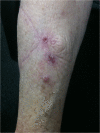Incidence, clinical spectrum, diagnostic features, treatment and predictors of paradoxical reactions during antibiotic treatment of Mycobacterium ulcerans infections
- PMID: 24007371
- PMCID: PMC3854792
- DOI: 10.1186/1471-2334-13-416
Incidence, clinical spectrum, diagnostic features, treatment and predictors of paradoxical reactions during antibiotic treatment of Mycobacterium ulcerans infections
Abstract
Background: Paradoxical reactions from antibiotic treatment of Mycobacterium ulcerans have recently been recognized. Data is lacking regarding their incidence, clinical and diagnostic features, treatment, outcomes and risk factors in an Australian population.
Methods: Data was collected prospectively on all confirmed cases of M. ulcerans infection managed at Barwon Health Services, Australia, from 1/1/1998-31/12/2011. Paradoxical reactions were defined on clinical and histological criteria and cases were determined by retrospectively reviewing the clinical history and histology of excised lesions. A Poisson regression model was used to examine associations with paradoxical reactions.
Results: Thirty-two of 156 (21%) patients developed paradoxical reactions a median 39 days (IQR 20-73 days) from antibiotic initiation. Forty-two paradoxical episodes occurred with 26 (81%) patients experiencing one and 6 (19%) multiple episodes. Thirty-two (76%) episodes occurred during antibiotic treatment and 10 (24%) episodes occurred a median 37 days after antibiotic treatment. The reaction site involved the original lesion (wound) in 23 (55%), was separate to but within 3 cm of the original lesion (local) in 11 (26%) and was more than 3 cm from the original lesion (distant) in 8 (19%) episodes. Mycobacterial cultures were negative in 33/33 (100%) paradoxical episodes. Post-February 2009 treatment involved more cases with no antibiotic modifications (12/15 compared with 11/27, OR 5.82, 95% CI 1.12-34.07, p = 0.02) and no further surgery (9/15 compared with 2/27, OR 18.75, 95% CI 2.62-172.73, p < 0.001). Six severe cases received prednisone with marked clinical improvement. On multivariable analysis, age ≥ 60 years (RR 2.84, 95% CI 1.12-7.17, p = 0.03), an oedematous lesion (RR 3.44, 95% CI 1.11-10.70, p=0.03) and use of amikacin in the initial antibiotic regimen (RR 6.33, 95% CI 2.09-19.18, p < 0.01) were associated with an increased incidence of paradoxical reactions.
Conclusions: Paradoxical reactions occur frequently during or after antibiotic treatment of M. ulcerans infections in an Australian population and may be increased in older adults, oedematous disease forms, and in those treated with amikacin. Recognition of paradoxical reactions led to changes in management with less surgery, fewer antibiotic modifications and use of prednisolone for severe reactions.
Figures





References
-
- World Health Organisation. Treatment of Mycobacterium ulcerans disease (Buruli ulcer): guidance for health workers. Geneva, Switzerland; 2012.
-
- Johnson PD, Hayman JA, Quek TY, Fyfe JA, Jenkin GA, Buntine JA, Athan E, Birrell M, Graham J, Lavender CJ. Consensus recommendations for the diagnosis, treatment and control of mycobacterium ulcerans infection (Bairnsdale or Buruli ulcer) in Victoria, Australia. The Medical journal of Australia. 2007;186(2):64–68. - PubMed
MeSH terms
Substances
LinkOut - more resources
Full Text Sources
Other Literature Sources
Medical

